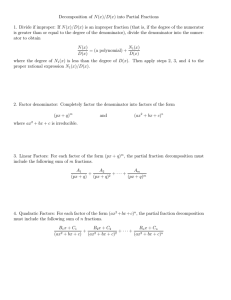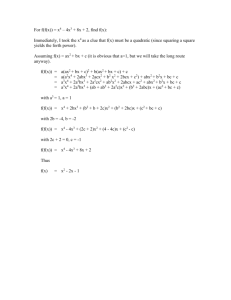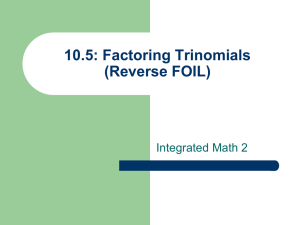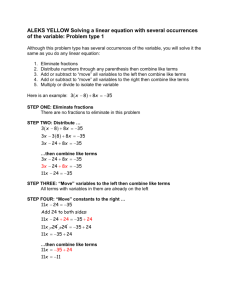Partial fractions
advertisement
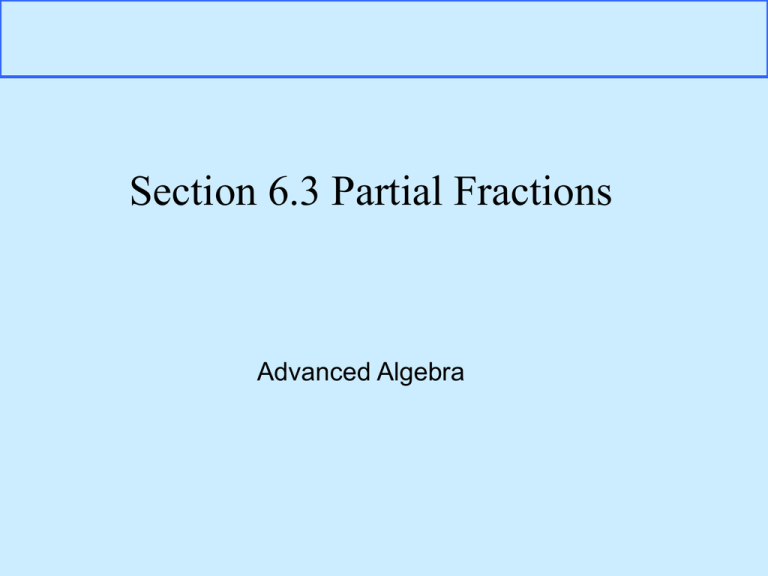
Section 6.3 Partial Fractions Advanced Algebra What is Partial Fraction Decomposition? There are times when we are working with Rational f ( x) Functions of the form when we want to g ( x) split it up into two simpler fractions. The process that we go through to do this is called “partial fraction decomposition” Let’s say you had the following: What would you need to do to add them together? 3 ( x 1) 4 ( x 4) ( x 4) ( x 1) ( x 1) ( x 4) 3x 3 4 x 16 ( x 4)( x 1) 7 x 13 ( x 4)( x 1) 3 4 x 4 x 1 Multiply by a common denominator to both fractions Write as one fraction and simplify the numerator The final answer Partial Fraction Decomposition is the reverse of what we just did here… 2 x x 2 2 A B x x 2 x x 2 Break into 2 smaller fractions 2 xx 2 Axx 2 Bxx 2 x x 2 x x2 2 Ax 2 Bx Multiply by LCD Cancel anything necessary 2 Ax 2 A Bx 2 2A 1 A 0 Ax Bx 0 A B Collect like terms and set equal 0 1 B 1 B 1 1 x x2 5x 3 x2 2x 3 5x 3 A B x 3 x 1 x 3 x 1 Multiply by the common denominator. 5x 3 A x 1 B x 3 5 x 3 Ax A Bx B 3 5x Ax Bx 5 A B 3 A B 3 3 A 3B Collect like terms together and set them equal to each other. Solve two equations with two unknowns. 5 A B 5x 3 x2 2x 3 3 A 3B 3 A 3B 8 4B 5x 3 A B x 3 x 1 x 3 x 1 2B 5 A2 3 A 5x 3 A x 1 B x 3 5 x 3 Ax A Bx B 3 5x Ax Bx 5 A B 3 A B 3 3 A 3B 3 2 x 3 x 1 This is called Solvetechnique two equations with Fractions twoPartial unknowns. 11 2 A 5B 4 2 A 2 B 11x 2 10 x 2 3x 1 11x 2 A B 2 10 x 3x 1 5 x 1 2 x 1 1 B 11x 2 A(2 x 1) B(5x 1) 2 A 1 11x 2 A2 x 1A B5 x 1B 11x A2 x B5 x 2 A B 7 7B 3 A 3 A 11 2 A 5B 3 1 5x 1 2x 1 Sometimes you might get a repeated factor (multiplicity) in the denominator 6x 7 A B Repeated roots: we must 2 2 use two terms for partial x 2 x 2 x 2 fractions. 6 x 7 A x 2 B 6 x 7 Ax 2 A B 6x Ax 7 2A B 6 A 7 26 B 7 12 B 5 B 6 5 x 2 x 2 2 Partial-Fraction Decomposition Repeated linear factor 4x 2 7x 3 x 2x 12 4x 2 7 x 3 A B C 2 2 x 2 x 1 x 2x 1 x 1 4x2 7 x 3 Ax 1 Bx 2x 1 Cx 2 2 4x 2 7 x 3 A x 2 2x 1 B x 2 x 2 Cx 2 4 x 2 7 x 3 Ax2 2 Ax A Bx2 Bx 2B Cx 2C 4 x 2 Ax2 Bx2 7 x 2 Ax Bx Cx 3 A 2 B 2C 4 x 2 Ax2 Bx2 7 x 2 Ax Bx Cx 4 A B 7 2 A B C Now we have 3 equations with 3 unknowns. Solve like in previous section. 11 5 A 4 B 4 3 B 16 4 A 4 B 1 B 27 9 A 3 A 3 A 2 B 2C 14 4 A 2 B 2C 11 5 A 4 B 3 3 21 2C 3 1 2C 4 2C 3 1 2 x 2 x 1 x 12 2C 2 x3 4 x 2 x 3 x2 2 x 3 If the degree of the numerator is higher than the degree of the denominator, use long division first. 2x x 2 2 x 3 2 x3 4 x 2 x 3 2 x3 4 x 2 6 x 5x 3 5x 3 2x 2 x 2x 3 (from example one) 5x 3 3 2 2x 2x x 3 x 1 x 3 x 1 What if the denominator has a nonfactorable quadratic in it? 7 x 4x 2 ( x 1)( x 2) 2 Partial Fraction Decomposition can get very complicated, very quickly when there are non-factorable quadratics and repeated linear factors…here is an easy example… 7 x2 4x Ax B C 2 2 ( x 1)( x 2) x 1 x 2 7 x 4 x 0 ( Ax B)( x 2) C ( x 1) 2 2 7x2 4x 0 Ax2 2 Ax Bx 2B Cx 2 C Ax2 Cx 2 7 x 2 2 Ax Bx 4 x 2B C 0 Now just solve the 3 by 3 system… A=3, B=2 and C=4 A nice shortcut if you have non-repeated linear factors—the Heaviside Shortcut—named after mathematician Oliver Heaviside (1850-1925)… x2 ( x 5)( x 1) Tell yourself, “if x is 5, then x-5 is 0.” Cover up the x-5 and put 5 in for the x in what is left… x2 A B ( x 5)( x 1) x 5 x 1 Do the same for the other linear factor 3 1 x2 4 4 ( x 5)( x 1) x 5 x 1 52 3 A 5 1 4 1 2 1 B 1 5 4 Which should probably be simplified… A challenging example: x first degree numerator 2 x 4 2 1 x 1 irreducible quadratic factor 2 Ax B C D 2 x 1 x 1 x 12 repeated root 2 x 4 Ax B x 1 C x 2 1 x 1 D x 2 1 2 2 x 4 Ax B x 2 2 x 1 C x 3 x 2 x 1 Dx 2 D 2 x 4 Ax3 2 Ax2 Ax Bx2 2Bx B Cx3 Cx 2 Cx C Dx 2 D 2 x 4 Ax3 2 Ax2 Ax Bx2 2Bx B Cx3 Cx 2 Cx C Dx 2 D 0 A C 0 2A B C D 1 0 1 2 A 2 B C 4 B C D 0 0 1 0 1 0 0 2 1 1 1 2 1 1 0 0 2 r 3 2 r 1 0 0 1 3 0 1 0 1 1 4 3 r 2 0 1 1 1 4 0 1 1 1 4 1 0 1 0 0 1 0 1 0 0 0 0 3 2 1 0 1 0 4 2 2 0 0 1 0 0 1 0 1 1 1 0 1 1 1 4 0 0 1 1 3 r2 r3 1 0 1 0 0 1 0 1 0 0 0 0 1 3 0 1 0 1 1 4 3 r 2 0 0 1 0 0 1 0 1 1 1 r 4 0 1 1 1 4 0 0 0 1 1 1 0 1 0 0 1 0 1 0 0 0 0 1 0 0 1 0 1 1 1 0 0 1 0 0 1 0 0 1 2 0 0 1 1 3 0 0 0 1 1 1 0 1 0 0 1 0 0 0 2 0 0 1 0 0 1 0 1 1 1 0 0 1 0 0 1 0 0 1 2 0 0 0 2 2 0 0 0 1 1 r2 r3 2 r3 x 2 x 4 2 1 x 1 2 Ax B C D 2 2 x 1 x 1 x 1 2x 1 2 1 2 x 1 x 1 x 12 We can do this problem on the TI-89: 2 x 4 expand 2 2 x 1 x 1 expand ((-2x+4)/((x^2+1)*(x-1)^2)) 1 0 0 0 2 F2 03 1 0 0 1 0 0 1 0 2 2 x 1 2 1 Of course with the TI-89, we could 0 integrate 0 0and wouldn’t 1 1 need just x2 1 x2 1 x 1 x 12 partial fractions! p
